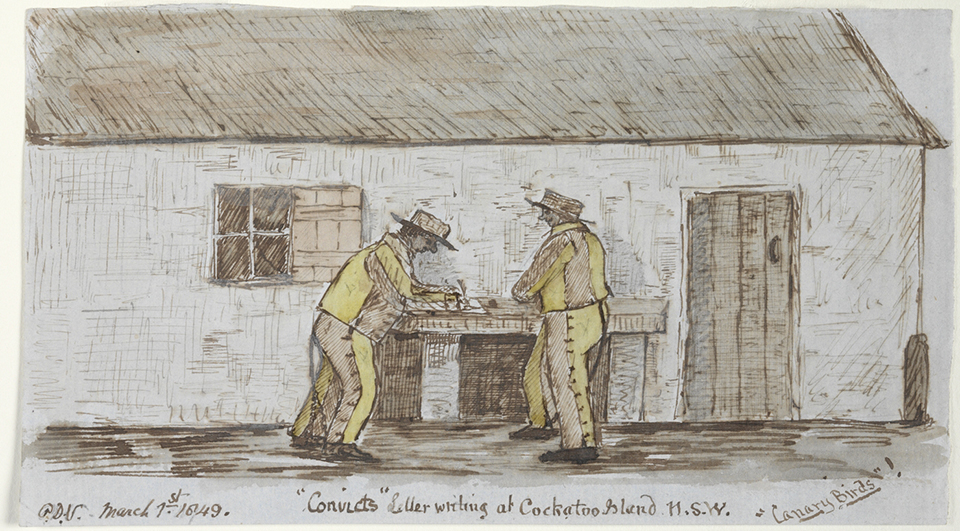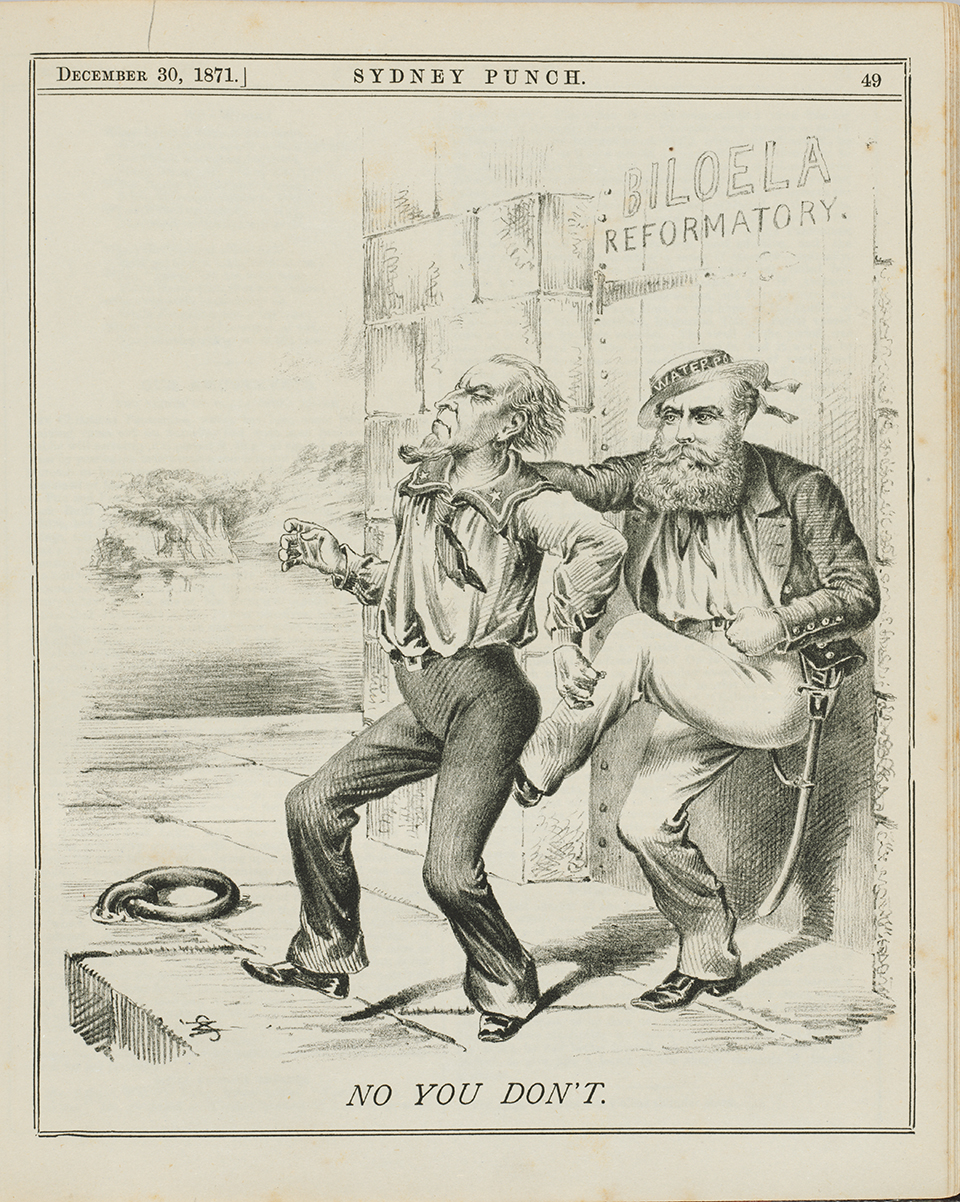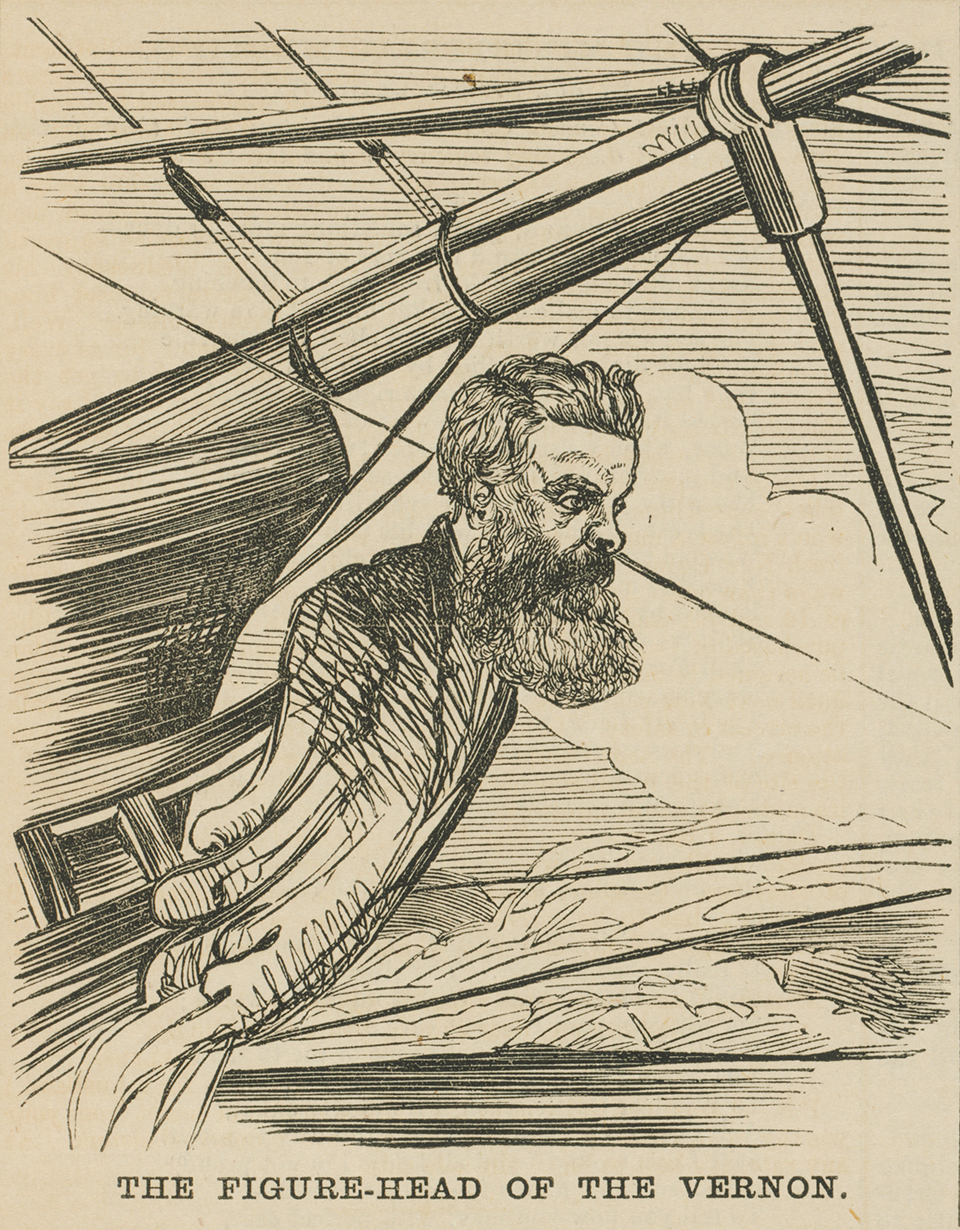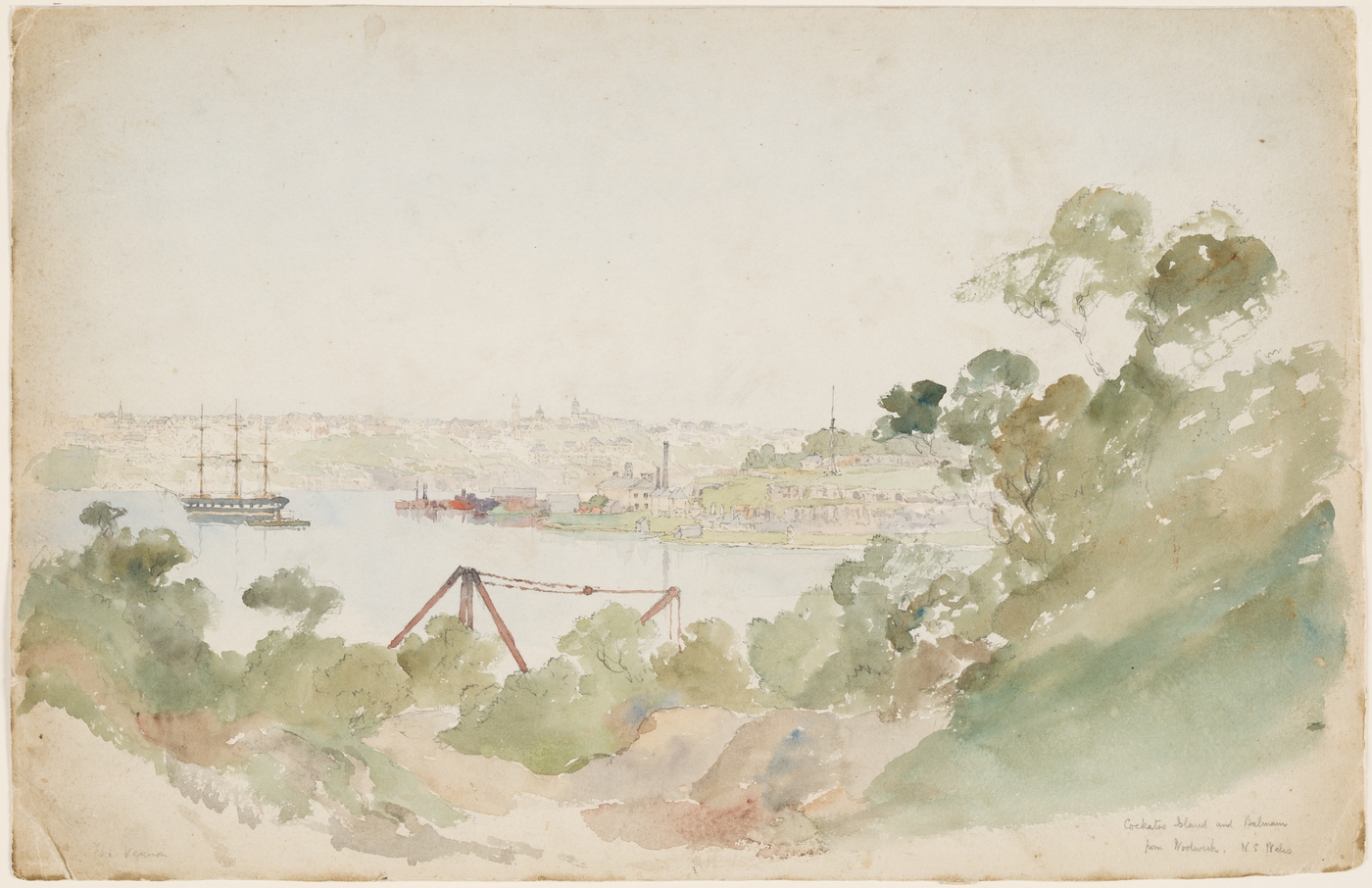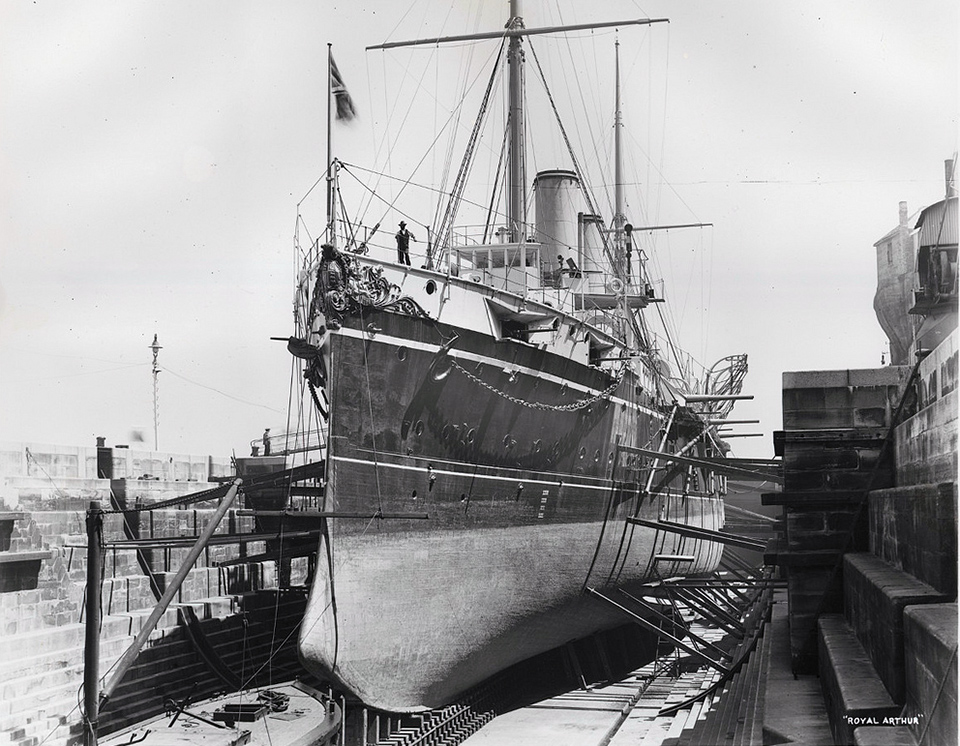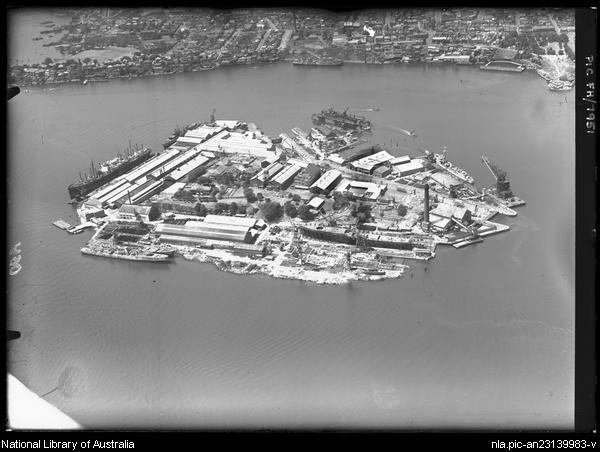The Dictionary of Sydney was archived in 2021.
Cockatoo Island
Citation
Persistent URL for this entry
To cite this entry in text
To cite this entry in a Wikipedia footnote citation
To cite this entry as a Wikipedia External link
Cockatoo Island
Over the course of 170 years, few locations in Sydney have changed as dramatically as Cockatoo Island. Its size, shape and texture today bear little resemblance to the uninhabited, rocky, tree-covered island it was in 1839, when the British decided to build a prison on it.
As Sydney grew from a colonial settlement into a city, Cockatoo Island changed inexorably. Its wooded slopes were cleared, its upper parts were levelled for the construction of prison barracks, and its sandstone foreshores were blasted with gunpowder to construct a dry dock.
The island's size actually increased when cutting and filling formed extensive aprons to accommodate shipbuilding. Once 12.9 hectares, the largest island in Sydney Harbour, today Cockatoo Island is 17.9 hectares, a magnificent artefact of nineteenth-and twentieth-century penal and industrial development.
Wareamah
The Aboriginal name for Cockatoo Island is Wareamah. Both names are found in a list of place names compiled by Governor Arthur Phillip and others in 1791. [1]
Cockatoo Island is in the country of the Wangal clan, whose territory extended from Darling Harbour to Parramatta on the harbour's southern shore. The redoubtable Bennelong is the most celebrated member of the clan.
Little is known of the use made of the island by the Wangal clan or other Indigenous people of the Sydney region. As saltwater people, the clan would have fished from and around the island and perhaps used its trees for the construction of canoes.
It is a pleasing thought that boat building on Cockatoo Island may have had its origins many thousands of years ago.
A place for a prison
[media]In 1839, Governor Gipps chose Cockatoo Island to build a new prison for secondary offenders, transported convicts who had re-offended in the colony.
Gipps considered it less expensive to build a new prison close to home than to expand the overcrowded penal settlement on faraway Norfolk Island where secondary offenders were customarily sent. Cockatoo Island appealed to him, 'surrounded as it is by deep water, and yet under the very eye of Authority'. [2]
The island had other advantages. Gipps soon put the convicts to work quarrying the island's high quality sandstone for the construction of the circular wharf at Sydney Cove (Circular Quay).
On the island's plateau, convicts also carved some 17 bottle-shaped storage silos out of the solid rock. The silos were up to 5.8 metres deep, 6.7 metres in diameter, with a sealed manhole at the top, and capable of holding up to 140 tonnes of grain.
However, this latter initiative by Gipps to safeguard the colony against wheat shortages in times of drought was vetoed by his masters in London. The Colonial Office preferred the play of free trade. Many of the silos remain today as a testament to the hard, dangerous labour performed by the island's convicts.
Living conditions on Cockatoo Island were barely satisfactory, even by the standards of the day. The convict-built barracks were soon overcrowded. Congestion and its attendant ills became a perennial feature of the prison and a constant spur to critics. At times, 500 convicts were crammed at night into the inadequate barracks accommodation.
Convicts provided all the services required to run the penal establishment's infrastructure. In addition to labouring, quarrying and conducting various trades such as bricklaying and carpentry, convicts were gatemen, overseers, messengers, servants, gardeners, hospital attendants, cooks and constables.
Convicts and maritime industry
In 1847, the convicts were put to work excavating a dry dock on Cockatoo Island for the repair of Royal Navy and other vessels. The decision reflected the demands of empire. Ships visiting Sydney were often in need of 'overhauling' before sailing to other parts of the Pacific, south-east Asia and China, where the British Empire had trading interests.
Construction took 10 years, considerably longer than expected due to the size and complexity of the task. There were ongoing tensions between the civil authorities in charge of the construction of the dock and the Superintendent of the prison who provided the labour. These tensions bedevilled efficient operating arrangements.
As for the convicts, various classifications worked under different conditions, which caused rancour. For many convicts, there was precious little incentive to meet the deadlines of the authorities.
Management under scrutiny
The management of Cockatoo Island was regularly the subject of political scrutiny.
The report of the 1858 Board of Inquiry into the management of the island found fault at the very top. [3] Charles Ormsby, the Superintendent of the prison, had presided over 'the most serious infraction of the rules'. He had diverted over 100 convicts from their duties in order to build stone walls and maintain an extensive private garden.
Ormsby lost his job. [4] His successor was Gother Kerr Mann who was placed in charge of both construction on the island and the convicts. A former military engineer, Mann lived with his wife and 12 children in Biloela, a large house on the island's highest point.
For the convicts, however, not much changed. The Engineer-in-Chief and Superintendent of Cockatoo Island was a somewhat aloof figure who showed little interest in penal administration.
In 1860, the convicts went on strike over the uneven manner in which the remission of sentences was administered. The ringleaders, heavily ironed, were marched off to Darlinghurst Gaol, a parade that scandalised Sydney. As the Sydney Morning Herald reported,
With one or two exceptions a more villainous looking band of ruffians could not be gathered on the face of the earth. They were of all countries, of all colours, of all ages, of all appearances, of recklessness and desperation, of some few with features moodily tinctured with sorrow, but without the faintest ray of hope about them. [5]
The 1861 Report of the New South Wales Legislative Assembly's Select Committee on Public Prisons in Sydney and Cumberland documented the prevailing conditions on Cockatoo Island.
Mr Inspector Lane… has often seen them (prisoners) at the iron gratings gasping for fresh air …. The brutalising effect upon the prisoners is admitted by all, and it is described by some as terrible in depravity. Crimes of the deepest dye are committed. [6]
Finally, in 1869, after 30 years, Cockatoo Island was closed as a penal establishment.
There must be some way out of here
Only one prisoner is recorded as having escaped from the island. During his second stint on the island for horse stealing, Frederick Ward swam to Balmain one night in 1863 and, aided by his Aboriginal common law wife Mary Ann Bugg, absconded to the bush.
As the bushranger Thunderbolt, Ward menaced northern New South Wales until he was shot by police at Uralla in 1870.
Ward probably knew Frank Gardiner, another convicted horse stealer imprisoned on Cockatoo Island. Not long after his release in 1859, Gardiner also embarked on a bushranging career, eventually joining up with Ben Hall, Johnny Gilbert and others. In 1862, the gang perpetrated the famous Eugowra Rocks robbery in central western New South Wales, relieving a gold escort of ₤12,000.
Girls on the island, boys too
[media]After the closure of the penal establishment, the island underwent a name change to Biloela, to soften its reputation as a hell-hole for recalcitrant men and to signal a new start. [7]
In 1871, an Industrial School for Girls and a separate Reformatory took up residence. The Industrial School housed orphans and neglected girls while the Reformatory incarcerated girls convicted of crimes.
[media]In the same year, an old ship Vernon was anchored off the north east corner of the island as a training base for up to 500 homeless or orphaned boys. This was a project championed by Henry Parkes. For the next 40 years, Vernon (1871–1890) and her successor Sobraon (1891–1911) taught boys trades such as tailoring, carpentry, shoe and sail making, as well as nautical skills. [media]Land was made available on the island for the boys' recreation and to grow vegetables.
The experiment or expedient of attempting to accommodate, rehabilitate and educate girls on Cockatoo Island failed. The girls on the island, sailors from visiting ships and the boys on the Vernon found ways to consort. As the Superintendent of the Vernon wrote to the authorities in 1871,
… three girls came down abreast of the ship, in a semi nude state, throwing stones at the windows of the workshops – blaspheming dreadfully and conducting themselves more like fiends than human beings, I was compelled to send all our boys onto the lower deck to prevent them viewing such a contaminatory exhibition. [8]
In 1879, the girls in the Reformatory were moved to a purpose-built residence at Watsons Bay. The Industrial School lasted until 1888 when the girls were moved to Parramatta.
Shipbuilding underway
In the early 1870s, shipbuilding began on Cockatoo Island. Dredges, barges and tugs were built. The Fitzroy Dock was busy servicing Royal Navy and colonial vessels, and in 1882 work began on the construction of a second dock. Sutherland Dock was completed in 1890 to accommodate the increasing size of ships visiting Sydney Harbour.
The more things change
After the Industrial School left Cockatoo Island, the former prison precinct became a gaol to house both male and female prisoners from 'the broken down class of metropolitan vagrants'. The gaol was intended to be temporary, to alleviate overcrowding at Darlinghurst Gaol where a system of separate cells for offenders was being introduced.
On average, the gaol accommodated about 200 prisoners in conditions that were found wanting by the Comptroller General of Prison, Harold Maclean.
The mode of the intended occupation of Biloela (in large dormitories)… is not to be defended, save in the exigency existing from the absence of a metropolitan penitentiary… [9]
When Biloela finally closed in 1908, it marked the end of an era. Cockatoo Island had been a prison of one sort or another for almost 70 years. For most of that time, the penal settlement had coexisted with a growing maritime presence on the island. [media]For the next 80 years, the island's tradition of shipbuilding and repair would establish it as one of Australia's great industrial sites.
Dockyard of the Royal Australian Navy
[media]In the years to the outbreak of World War I, some 150 small vessels had been constructed on Cockatoo Island. In 1913, the island was transferred to the Commonwealth and became the naval dockyard of the Royal Australian Navy.
The torpedo boat destroyer Warrego was the first naval ship launched at Cockatoo Island. Built in Great Britain, dismantled and shipped to Australia, Warrego was reassembled on the island and commissioned in 1912.
At its peak during World War I, some 4,000 men were employed on the island. The conversion or refitting of transport ships was a major activity. Ships were often refitted a number of times to carry troops and horses.
After the war, the shipyard built the cruiser HMAS Adelaide, the collier Biloela , two cargo ships, two refrigerated cargo ships and a seaplane carrier, HMAS Albatross, launched in 1928. However, in the 1920s shipbuilding declined after a High Court judgment precluded the dockyard from accepting work other than from the government.
As a consequence, the Commonwealth decided to lease the island to the private sector.
On the wing
For a few years in the early 1930s, Cockatoo Island was home to the design and repair of aircraft. Under the authority of LJ (later Sir Lawrence) Wackett, an aeronautical engineer and aircraft designer, the so-called Aircraft Department carried out repairs to civil and military aircraft.
Wackett designed and built for Kingsford Smith a small passenger aircraft named Codock. The Aircraft Department closed down in 1934.
Adaptation
Throughout the twentieth century, the demands of shipbuilding continually modified Cockatoo Island. By the 1930s, it barely resembled the pristine land mass of the early nineteenth century. The island was very much an industrial complex, although there were a number of families living on the island – and even a few sheep.
The skyline was distinguished by cranes, chimneys and water towers. The aprons and the upper plateau were crammed with workshops, factories and a host of functional sheds and stores. The convict-built barracks and residences were used as accommodation and offices by dockyard management.
The built environment reflected changes in technology. It also reflected the island's social structure. Most trades were located on the lower parts of the island while management occupied the plateau. The heavily unionised workforce inevitably led to demarcation disputes between unions, and at times a rancorous relationship with the dockyard administration.
Landmarks – the powerhouse and floating crane
Cockatoo Island's powerhouse was completed in 1920. Three 1000 kilowatt turbo-generator sets, air compressors and hydraulic units supplied power for the lighting, welding, hydraulic and pneumatic needs of the dockyard.
Two centrifugal pumps, each with a capacity of 10,000 tons per hour, emptied the docks. On the western wall, 12 Hewittic mercury arc glass rectifier units converted AC electricity from the shore to DC electricity to power the island's machinery.
The [media]floating crane Titan was a familiar sight around Cockatoo Island and the harbour for over 70 years. Titan was a very big piece of machinery. Its pontoon was 54 metres long and 24 metres wide. The jib, designed to lift 150 tons, was 58 metres above the deck at full extent, almost as high as a 20-storey building. The crane was powered by steam-driven electric generators and operated by a crew of 12 men. Titan lifted everything from turbines, armaments, small tugs and patrol craft to power station equipment, locomotives and parts of the Spit, Iron Cove and Gladesville Bridges. Two or three tugs shunted it around Cockatoo Island and work sites on the harbour.
The great shipbuilding enterprise
As the 1930s progressed, shipbuilding activity on Cockatoo Island picked up. It was augmented by the routine servicing of naval, merchant and passenger ships, the repair of ships and the refit of naval ships such as the cruiser HMAS Australia.
As World War II approached, the tempo of activity increased and continued for the duration of the war. Merchant ships and luxury liners such as the Cunard liners Queen Mary and Queen Elizabeth were converted to troop transports, stores and hospital ships.
Cockatoo Island was the main ship repair facility in the south-west Pacific. In 1943 the USS New Orleans had over 150 feet (45.7 metres) of her bow torn away in a torpedo hit in the battle of Lunga Point, Guadalcanal. The cruiser steamed backwards to Sydney for repairs. A false bow was fitted at Cockatoo Island to enable the ship to return to San Francisco for reconstruction.
HMAS Australia, a veteran of the Battle of the Coral Sea, was a regular visitor to Cockatoo Island during the war. In 1945, she suffered kamikaze attacks in the Philippines and steamed home for repairs at the island.
The engineering [media]capacity of Cockatoo Island was second to none. Other shipyards around Australia depended on Cockatoo's technical skills and practical experience. Cockatoo's workforce manufactured boilers, turbine machinery and components for other shipyards and it was the leading yard in crucial shipbuilding programs. The dockyard provided the training for apprentices in many trades.
The postwar period
In the [media]postwar period, the dockyard built Battle Class and Daring Class destroyers, and anti-submarine frigates as well as modernising and refitting many naval vessels.
[media]Probably its most famous ship was HMAS Voyager. Completed in 1957, the destroyer collided with the aircraft carrier and fleet flagship HMAS Melbourne in February 1964 off Jervis Bay during exercises. Voyager sank with the loss of 82 lives. Melbourne returned to Cockatoo Island for repairs.
When the government placed orders for two guided missile destroyers with a United States shipbuilder in 1961, Cockatoo Island was obliged to compete with commercial shipyards for the construction of merchant ships. Experience around the world demonstrated that mixing naval and merchant shipbuilding was a difficult balance to get right.
The last hurrah
In 1962, Cockatoo Island won the tender to construct Empress of Australia which, when completed in 1965, was the largest roll-on roll-off cargo passenger ship in the world. It operated a service between the mainland and Tasmania until 1985, when it was sold overseas.
Cockatoo Island won the contract to build the escort maintenance ship HMAS Stalwart in 1963 and a year later for HMAS Torrens.
During the 1970s, the dockyard lost out on major tenders and undertook a range of small projects such as the construction of flat-top lighters and a slave dock.
In 1979, the contract was signed for the construction of the last ship to be built at Cockatoo Island. HMAS Success, the largest naval vessel built in Australia, was a fleet underway replenishment ship, a splendid description for a ship that supplies other ships at sea. Success was handed over to the Navy in 1986 and may still be seen in Sydney Harbour from time to time.
Submarines
The docking and refitting of submarines on Cockatoo Island began as early as 1914 when the newly established Royal Australian Navy took possession of two British E Class submarines.
By the 1960s, a Royal Australian Navy submarine service had been established and disbanded at least twice. Dockings and refittings took place at Cockatoo Island, sometimes at Garden Island.
In 1963, the government placed an initial order for four Oberon Class submarines. An [media]additional two were ordered in the late 1970s. Cockatoo Island was responsible for the docking and refitting program.
From 1971 to 1991, Cockatoo Island completed 14 major refits and many dockings for repairs of Australia's Oberon Class submarines.
Cockatoo Island today
When the lease for Cockatoo Island expired in December 1992, the future of the island was far from certain. There was a strong likelihood that Cockatoo Island, along with former defence lands around the harbour, would be sold. In the community, there were calls to keep the island in public hands and to celebrate its convict and industrial heritage.
In 2001, the Commonwealth government established the Sydney Harbour Federation Trust to plan for the future uses of these lands.
The Trust has undertaken a program of capital works on Cockatoo Island to remediate the contaminated site and renovate and conserve buildings, equipment and facilities of high heritage value.
In 2010, the island's convict remnants received World Heritage listing with 10 other convict sites around Australia.
Once off-limits to the public, Cockatoo Island is now open. It has a camping ground, and a number of island residences have been converted into short-stay holiday accommodation. A three-day music and cultural festival in 2005 has been followed by major events, exhibitions and installations, including the Biennale of Sydney.
The Trust has revitalised this once-great shipbuilding yard and former penal establishment and gaol, whilst preserving its character. The island's history and heritage will continue to inform new uses that promise to make this great landmark a notable contributor to the ongoing story of Sydney.
References
Patrick Fletcher, The Story of Cockatoo Island, Sydney Harbour Federation Trust, Sydney, 2010
John Jeremy, Cockatoo Island, Sydney's Historic Dockyard, University of New South Wales Press, Sydney, 2005
James Kerr, Cockatoo Island: Penal and institutional remains, National Trust of Australia (NSW), Sydney, 1984
Notes
[1] Anon, Vocabulary of the language of N. S. Wales in the neighbourhood of Sydney (Native and English, but not alphabetical), c 1791. Ms 41645, Book C, School of Oriental and African Studies, University of London, London
[2] Correspondence to Lord Glenelg, Secretary of State for War and the Colonies, 8 July 1839, Historical Records of Australia, series 1, vol 20, Sydney, 1924, p 217
[3] Report from the Board of Inquiry into the Management of Cockatoo Island, NSW Legislative Council, 1858
[4] The regulations allowed Ormsby just one gardener. In his defence, Ormsby claimed that the gardens produced up to 40,000 cabbages a year
[5] Sydney Morning Herald, 21 January 1861, p 7
[6] Report from the Select Committee on the public prisons in Sydney and Cumberland, Sydney, 1861
[7] Biloela is a Kamilaroi word for cockatoo. It was recorded by the Reverend William Ridley in Kamilaroi, Dippil and Turrubul: Languages Spoken by Australian Aborigines, Sydney, 1866. The Kamilaroi people lived in central northern New South Wales
[8] Mien, I S V, letter to Principal Under Secretary, 17 October 1871, State Records New South Wales
[9] Annual Prison Report, 1888
.


